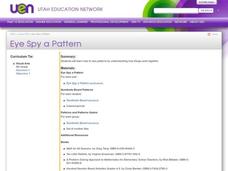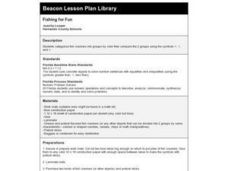Curated OER
Less is More: Realizing Mathematics Through Agriculture
Learners study the architectural designs of different popular sites. For this math lesson, students draw a grid diagram. They explain what geodesic algorithms are used for.
Curated OER
The Exact Differential
Students integrate functions using u substitution. In this integrating functions using u substitution lesson, students integrate functions by setting part of the function equal to u and the other part equal to du. Students integrate...
Curated OER
It Counts
Learners explore how numbers can identify objects. In this math lesson plan, students determine how numbers are used to describe objects used in quantitative data collection.
Curated OER
Lost in Translation
Students reflect on the uses of mathematics in their daily lives and work in pairs to design brochures that make specific mathematical concepts clear and interesting to a popular audience.
Curated OER
Exploring Area/Perimeter Through Coordinate Geometry
Students explore area and perimeter through coordinate geometry using student literature, hands-on manipulatives, and the Internet.
Curated OER
Babylonian Square Roots
Students are introduced to a method for finding square roots used by the Babylonian people of Mesopotamia. The method involves dividing and averaging, over and over, to find a more accurate solution with each repeat of the process.
Curated OER
Eye Spy a Pattern
Fifth graders identify patterns by understanding how things work together.
Curated OER
Introducing Trig
Fifth graders explore the importance of triangles in the real world. They find the unknown side of a right triangle using a scale drawing. Students use Pythagoras' Theorem and other appropriate ratios.
Curated OER
Diophantus II
Learners use an ancient math game to establish the context for solving problems by investigating them in a systematic and mathematical way. They also need to have the ability to solve various types of equations.
Curated OER
Fibonacci Numbers
Students calculate the Fibonacci sequence of numbers. Through the use of Fibonacci numbers in flowers, leaves, fruits, vegetables, pine cones, and other forms of nature; students explore how Fibonacci numbers occur in nature. Then they...
Curated OER
Pi
Sixth graders read the book "Sir Cumference and Knights of the Round Table" to introduce them to the concept of Pi. As a class, they discover where Pi originated and define the terms circumference, radius and diameter. To end the...
Curated OER
Eye Spy a Pattern
Fifth graders examine how to see patterns by showing how things work together. They identify, analyze and determine a rule for predicting and extending numberical patterns involving operations of whole numbers, decimals and fractions.
Curated OER
Exploring Special Lines
Learners compare and order numbers. In this geometry lesson, students write equations for inequalities. They differentiate and apply concepts of triangular properties to solve problems.
Curated OER
Aeronautics: Bernoulli's Principle
Students explore physics by participating in a science activity in class. In this flight properties lesson, students identify Bernoulli's principle of flight and his theory of statics and motion. Students conduct a demonstration by...
Curated OER
Introduction to Probability
Students define experiment, outcome, event, and probability, and explain the formula for finding the probability of an event.
Curated OER
Lines of Symmetry
Fourth graders demonstrate lines of symmetry using polygons, pentominoes, and block letters of the alphabet. They describe, identify, and analyze characteristics and properties of geometric shapes.
Curated OER
Placing Negative Numbers On A Number Line
Fifth graders review the concept of negative numbers and how the are placed on a number line. After the review, 5th graders practice placing negative numbers on a number line in a whole class setting.
Curated OER
Prime Factors
Fifth graders review the concept of prime factorization. Then, they use the rules for divisibility and other notions to find the prime factorization of unfamiliar numbers. They solve problems in a whole class setting.
Curated OER
Fishing For Fun
Second graders categorize fish crackers into groups by color and compare the two groups using the symbols <, =, and >. They use concrete objects to solve number sentences with equalities and inequalities.
Curated OER
The Nuts and Bolts of a Mathematical Expression
Fourth graders complete a worksheet that asks them to order operations within a mathematical expression. students evaluate the expressions in the correct order using mental math and paper. The results are recorded on the worksheet.
Curated OER
The Final Word
Middle schoolers research biographies of Americans who advanced science. They create an obituary for the person to share what information they have gathered. They discuss the importance of the obituary as the "final word" of a person to...
Curated OER
Basic Algebra - Lesson 4 Order of Operations
Ninth graders study the correct way to solve equations using the order of operations. They apply a mnemonic device to remember the proper order.
Curated OER
Mapping Data Made Manageable
Students explore how to select unbiased random samples as they choose report data to include on maps. They propose methods for choosing random numbers and discuss their advantages and disadvantages. They consider bias in science.
Curated OER
Collision Course
Students measure the speed of moving marbles and use the results to calculate velocity and momentum. They analyze the events preceding a Japanese train crash.
Other popular searches
- Famous Mathematicians
- Great Mathematicians
- 5 Great Mathematicians
- Female Mathematicians
- Projects on Mathematicians
- Five Great Mathematicians
- The Great Mathematicians
- Mathematicians Fibonacci
- List of Great Mathematicians
- Hall of Great Mathematicians
- Whorls Famous Mathematicians
- The Old Grete Mathematicians

























